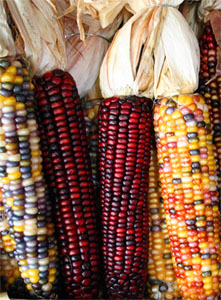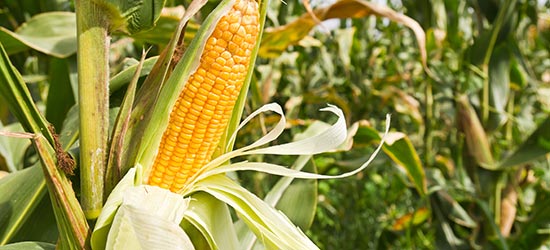Maize

Climatic requirements for Maize Cultivation
In most Asian countries, maize is primarily a rain fed crop which is sown just before monsoon rains . This maize crop usually thrives best under temperatures varying from 21 °C-30°C, although it can tolerate temperatures as high as 35°C.This crop is effected by frost, so it is grown where at least 5 frost free months available in a year. It requires at least 50 to 100 mm of rainfall. It is not recommended to cultivate this crop in the areas where rainfall is more than 100 mm.
Sowing Season for Maize Cultivation
The maize crop is usually grown in Asia during June to July, September to October and Jan to Feb seasons. For maize seed production, sowing during Nov to Dec is suitable since seed maturity will not coincide with rainy season.
Land Selection and Field Preparation
The selected field should be free of volunteer maize plants. What are volunteer plants?: volunteer plants are basically unwanted plants that are grown from previous maize crop. These maize plants may be different variety, so there is chance that genetic contamination may occur. Ploughing should be done to get fine tilth stage of soil and make the field weed free. It may take 5 or 7 ploughings to bring the soil to friable stage. At least 15 to 20 tons of well decomposed farm yard manure (FMY)/ha should be applied across the field or composted coir pith and apply 10 Azospirillum packets in the field. Prepare furrows and ridges with 45 cm to 50 cm spacing to save the irrigated water.
Seed Rate and Seed Treatment
11 to 12 kg of maize seed is required for sowing one hectare land. To control seed borne pathogens of downy mildew (fungal disease), should treat seeds with thiram or carbendazim @ 2 grams per kg of seeds. One day after seed treatment, should treat the seeds with 600 grams of Azospirillum with rice gruel and shade dry for 15 to 25 minutes. Azosprillum help in fixing the atmospheric nitrogen in the soil.
Sowing method in Maize Cultivation
In Maize Cultivation, propagation is done through seeds. It is recommended to adopt a plant-to-plant spacing of 10 cm and sow 2 seeds per hill. Should sow the seeds @ 1/3 rd of ridge from the bottom.
Manures and Fertilizers
Among all the cereals, maize in general and hybrids in particular are responsive to nutrients applied either through organic or inorganic sources. The rate of nutrient application depends mainly on soil nutrient status/balance and cropping system. For obtaining desirable yields, the doses of applied nutrients should be matched with the soil supplying capacity and plant demand by keeping in view of the preceding crop. Other than Farm Yard Manure applied at the time of land preparation, should apply inorganic fertilizers like 475 kg of super phosphate, 200 kg of urea, and 180 kg of potash per ha as basal dose. 20 days after sowing, should apply 50 to 60 kg of urea and at 45 days after sowing 120 kg of urea and 50 kg of potash as top dressing.
Micro Nutrients
Nutrient deficiency in maize affects the growth of the plant, so the yield. Zinc and Magnesium deficiency are very common and largely occurs in leaves. To deal with these deficiencies, make sure to apply ZnSO4 @ 20 to 22 kg per hectare as basal fertilizer. Magnesium deficiency will cause yellowish symptoms between edges and veins of basal leaves. Due to “Fe” or “Iron” deficiency, the whole plant will turn into yellowish color, to correct these deficiencies, supplement the micro nutrient mixture at 63 per hectare mixed with 45 kg of sand, after sowing the maize seeds in the field.
Maize Irrigation
Provide immediate irrigation after sowing is done in the field. Subsequent life irrigation should be given on 3rd or 4th day and based on the soil type and season. (It may no bet required in rainy season). Usually in maize cultivation, during initial to 3 to 4 weeks, less number of irrigation are recommended. Subsequent irrigation should be given once in a week. During early stage of this crop, water lagging should be avoided and should have good drainage in the soil.
Weed Control
It requires at least 2 to 3 hand weeding in maize crop, one is at 3 weeks time and another is in 40 to 45 days after sowing the crop. Apply fertilizers as top dressing and do the earthling up operation after weeding is completed. Spray Atrazin 500 grams mixed in 1000 liters of water and life irrigation on thirds or fourth day will check the weeds in maize crop field.
Diseases and Insects
The main diseases found in Maize cultivation are downy mildew and leaf spot.
- Downy mildew: In order to control this, remove the affected plants. Spray Metalaxyl 72 WP @ 1 kg per hectare, or Mancozeb 1 kg per hectare, 21 days after sowing.
- Leaf spot: To control this, spray Captan or Mancozeb kg per hectare when the disease intensity is high. Usually, insect attacks are very low in corn crop. In young plants, only shoot fly affects and stem borer affects the shoot after 21 to 30 days after sowing. As part of control measures, apply carbofuran granules @ 8 kg/acre @ 2 granules/ each plant.
Maize Harvesting
Harvesting should be done when the crop outer cover of the cob turns from green to white colour. Harvesting can be done by hand. Machines can be used to separate the seeds from the cob.
Maize Yields
Maize yield depends on various factors like the cultivar selected, soil type, farm management practices, methods followed and climatic conditions. With good filed management practices and good seed variety yield of 2500 kg per hectare can be obtained.
Marketing in Maize Cultivation: Can transport to local markets or nearest corn processing mills.
Bottom Line in Maize Cultivation: Farmers can get good profits in short period (4 months) of time with low
To find out more about how Plantations International can assist you with the development and management of your maize/corn farm to receive a free initial consultation, please call us today on +852 5808 3775 or Click Here to contact your nearest Plantations International representative.


